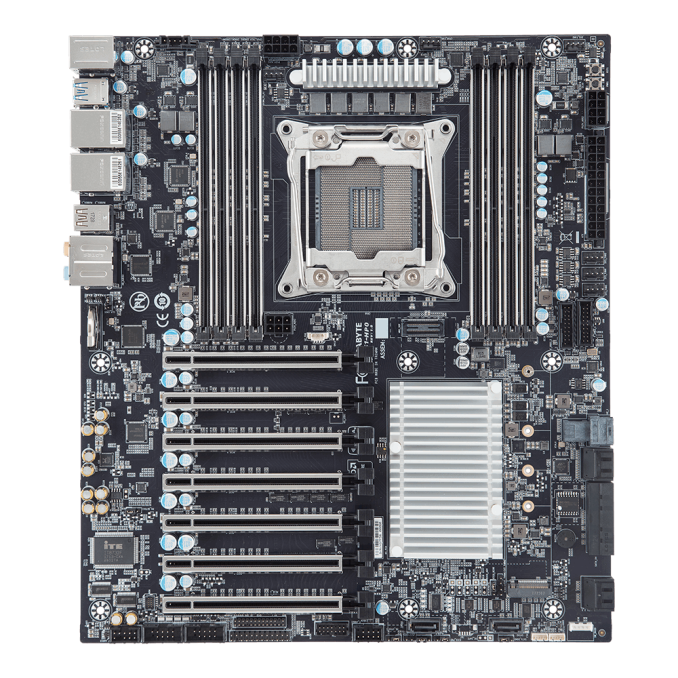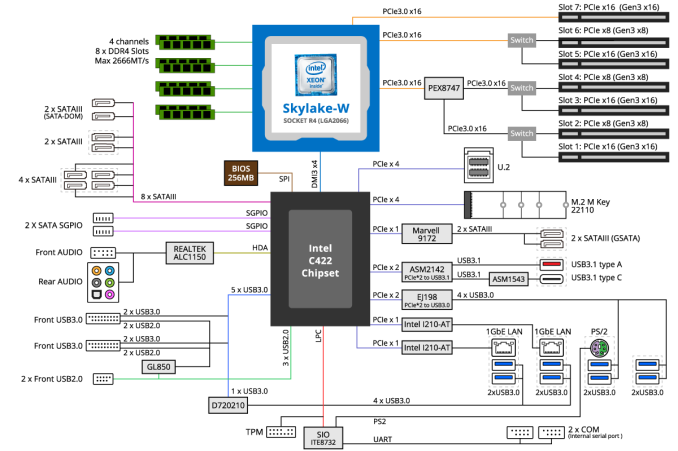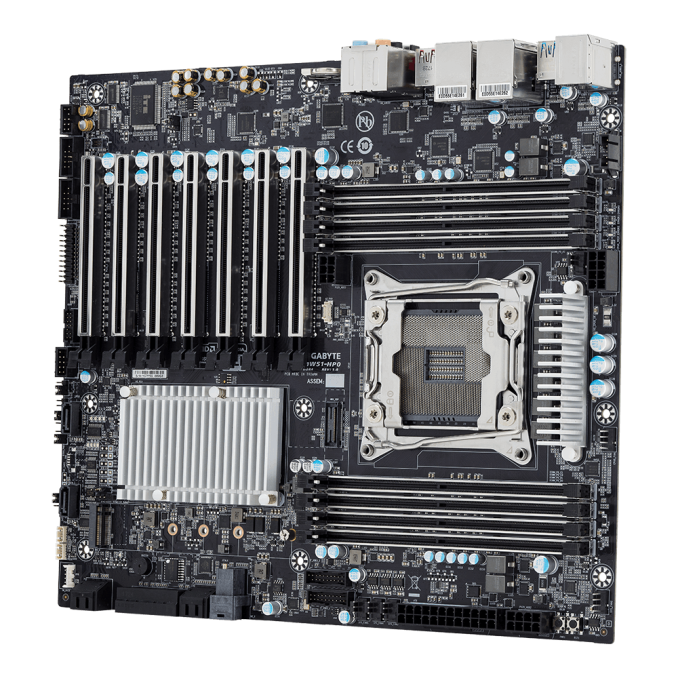GIGABYTE Server Announces MW51-HP0 Motherboard: C422 for Intel Xeon-W
by Joe Shields on August 29, 2017 4:35 PM EST- Posted in
- Motherboards
- Intel
- Gigabyte
- Workstations
- ECC
- Xeon-W
- C422

With Intel’s latest release of the Xeon-W processor line, they have bridged the gap between consumer and enterprise platforms once again making cross-compatibility easier. The Xeon Skylake-W CPU addresses these issues and is more or less, a Xeon version of the current Skylake-X processors with all the pro features enabled. Traits such as extended memory support, vPro, Intel’s AMT and the standard enterprise Reliability, Availability, and Serviceability (RAS) features are turned on and ready to go. This new set of processors, despite using the same LGA2066 socket as Skyake-X, will require a new chipset C422 and will not work in X299.
To that end, one of the first boards being released using this chipset was at Computex this year, where GIGABYTE Server showed off a motherboard named C422-WS. The name has changed on that board with today announcing the MW51-HP0. GIGABYTE Server's goal is to bring the Intel Skylake-SP architecture and single-socket platform for workstations to the prosumers and SOHO (Small Office, Home Office) segments that want Intel professional performance. GIGABYTE Server states that this new motherboard offers a "wealth of I/O options, including multiple PCIe lanes to support graphics, storage, and USB options, as well as direct SATA and USB ports."
Using Xeon-W CPUs, there are a total of 48 PCIe 3.0 lanes from the CPU to divide up (Skylake-X totaled 44 lanes) or the main PCIe slots, and another 24 PCIe 3.0 lanes from the chipset for add-in functionality. This enables a lot of flexibility in using PCIe based devices. Looking at the block diagram below, the seven PCIe slots have four dedicated PCIe 3.0 x16 slots along with three x8 slots. This would normally give a total of 64 lanes, however the MW1-HP0 uses a PEX8747 PCIe switch chip to multiplex one of the x16 lanes into two main x16 slots, allowing for a total of 64 PCIe lanes. This setup groups six of the seven PCIe slots together in pairs that share bandwidth - stick a card in a PCIe x8 slot, and the slot below it also drops down to x8. As a result, the MW51-HP0 is able to hold four dual slot PCIe cards, or a total of seven single slot PCIe expansion cards.
On the Rear I/O, users will find a PS/2 port, eight USB3.0 ports, two USB3.1 ports (one Type-A and one Type-C), the two Intel I210 based Gigabit Ethernet ports, and the audio stack running off the Realtek ALC1150 CODEC.
For storage purposes, the board is equipped with a total of 10 SATA ports. Eight come directly from the chipset, with two of those being SATA-DOM capable (also 2x SATA DOM SGPIO connectors), while the other two are driven by a Marvell 9172 Controller. Onboard, there is one M.2 slot and one U.2 slot both using PCIe x4 bandwidth from the chipset for high-speed boot purposes. The MW51-HP0 supports Intel software based RAID (0/1/10/5) for the SATA ports. If a user needs RAID NVMe drives, the board does come with a VROC module for PCIe RAID management. Place the module in the VROC port to unlock PCIe RAID options.
The MW51-HP0 has eight DIMM slots on the board supporting up to 512GB of DDR4 memory using 64GB LRDIMMs (256GB using 32GB RDIMM) in a quad channel configuration. Speeds up to 2666 MT/s can be used.
| GIGABYTE MW51-HP0 Specifications | |
| Warranty Period | 3 Years |
| Product Page | Link |
| Price | N/A |
| Size | CEB: 304.8mm(W) x 266.7mm(D) |
| CPU Interface | LGA2066 |
| Chipset | Intel C422 |
| Memory Slots (DDR4) | Quad Channel, Eight DDR4-2666 Slots Supporting 512GB Up to 32GB RDIMM or 64GB LRDIMM Modules |
| Network Connectivity | 2 x Intel I210 GbE |
| Onboard Audio | Realtek ALC1150 HD |
| PCIe Slots for Graphics (from CPU) | 7 x PCIe 3.0 (as per diagram above) |
| PCIe Slots for Other (from PCH) | N/A |
| Onboard SATA | 8 x SATA 6 Gbps ports - 2 x SATA DOM Supported (RAID 0/1/10/5) 2 x SATA 6 Gbps ports via Marvell 88SE9172 |
| Onboard SATA Express | None |
| Onboard M.2 | 1 x PCIe 3.0 x4 (Up to 110mm) |
| Onboard U.2 | 1 x PCIe 3.0 x4 |
| USB 3.1 | 1 x Type-A 1 x Type-C (both red and 5V/3A) ASMedia 2142 Controller |
| USB 3.0 | 8 on Rear Panel 2 Headers for 4 ports |
| USB 2.0 | 1 Header for 2 ports |
| Board Management / TPM | N/A / 1x TPM Header |
| Power Connectors | 1 x 24-pin ATX 1 x 8-pin CPU |
| Fan Headers | 1 x CPU (4-Pin) 5 x System Fan Headers (4-Pin) |
| IO Panel | 1 x PS/2 8 x USB 3.0 1 x USB 3.1 Type-A(red) 1 x USB 3.1 Type-C(red) 2 x RJ45 (Intel I210) 5 x Audio jacks 1 x Optical S/PDIF-Out |
| OS Supported | Windows 7 (x64) Windows 10 (x64) RHEL 6.8 (x64) RHWL 7.3 (x64) SUSE Linux Enterprise Server 11.4 (x64) SUSE Linux Enterprise Server 12.2 (x64) Ubuntu 16.04 LTS (x64) Ubuntu 10.10 LTS (x64) |
Pricing nor availability was listed at the time of publication, however we do expect to see this I/O laden, single-socket high-end workstation motherboard on the market soon.
A Quick Recap on Xeon-W
The Xeon-W CPUs range from the Xeon W-2123, a 4c/8t 3.6GHz SKU at 120W, up to the monster W-2195 18c/36t product at 2.3 GHz with 140W TDP.
| New Intel Xeon-W Processors (LGA2066) | |||||||
| Cores | Base Freq. |
Turbo 2.0 |
L3 (MB) |
L3/core (MB) |
TDP | Price | |
| Xeon W-2195 | 18/36 | 2.3 GHz | 4.3 GHz | 24.75 | 1.375 | 140 W | TBD |
| Xeon W-2175 | 14/28 | TBD | TBD | 19.25 | 1.375 | 140 W | TBD |
| Xeon W-2155 | 10/20 | 3.3 GHz | 4.5 GHz | 13.75 | 1.375 | 140 W | $1440 |
| Xeon W-2145 | 8/16 | 3.7 GHz | 4.5 GHz | 11.00 | 1.375 | 140 W | $1113 |
| Xeon W-2135 | 6/12 | 3.7 GHz | 4.5 GHz | 8.25 | 1.375 | 140 W | $835 |
| Xeon W-2133 | 6/12 | 3.6 GHz | 3.9 GHz | 8.25 | 1.375 | 140 W | $617 |
| Xeon W-2125 | 4/8 | 4.0 GHz | 4.5 GHz | 8.25 | 2.063 | 120 W | $444 |
| Xeon W-2123 | 4/8 | 3.6 GHz | 3.9 GHz | 8.25 | 2.063 | 120 W | $294 |
Related Reading
Source: GIGABYTE Server














15 Comments
View All Comments
The_Assimilator - Tuesday, August 29, 2017 - link
Now why can't desktop motherboards have the same IO panel layout with all the USBs, instead of a bajillion display outputs nobody's ever gonna use? I'd happily pay a few extra bucks more for a board with outputs I'll actually use. Even better, go with quad-stack USB 3.0 A-type connectors as used on e.g. the MAXIMUS IX FORMULA and MSI Z97 MPOWER and you have space to fit the damn display connectors, if they're so bloody necessary.But I guess blingy LEDs, "gaming-optimised" network chips and "audio isolation" snake oil are more important than useful connectivity to most.
Ro_Ja - Tuesday, August 29, 2017 - link
You'd want your pc to be usable as much as possible if your graphics card broke for example.For AM4's case however, it may look like it's worthless but it's because A12 CPUs are compatible with the current AM4 motherboard.
caqde - Tuesday, August 29, 2017 - link
There are at least a few AM4 motherboard's without display output capabilities. The Asus Crosshair VI Hero and Asrock X370 Taichi / Fatal1ty Professional Gaming boards for instance don't have video output's.Fujikoma - Wednesday, August 30, 2017 - link
Most people at this price point aren't going to be purchasing APUs to power that type of motherboard and will usually have a spare video card, or more, lying around. The only time I buy motherboards with multiple display options, is for family members when I'm footing the build bill.ltcommanderdata - Tuesday, August 29, 2017 - link
Interesting that C422 motherboards list official support for Windows 7. X299 motherboards provide Windows 7 drivers, but don't officially claim Windows 7 support. So does Skylake-W and C422 have full support from Microsoft with Windows 7 security updates until Windows 7 EOL in 2020 or is Microsoft going to block Skylake-W and C422 from Windows 7 security updates after-all despite Intel claiming Windows 7 is a supported configuration?Error415 - Tuesday, October 3, 2017 - link
Microsoft blocks Windows 7 updates on all cpu's post Skylake so Skylake X and W will not get updates. And a chipset having Windows 7 support means theres drivers available for that OS.Bullwinkle J Moose - Tuesday, August 29, 2017 - link
.....and why can't desktop CPU's maximize CACHE instead of maximizing core counts at the expense of cache?I'd like to see single and multi thread performance AND cache optimized up to the maximum die size allowance
Instead of gimping the L3 to 1.75MB on the Xeon-W, how about maximizing L1/L2 and L3 up to maybe 8 or 10 cores and then go back to gimping anything over 10 cores?
Start with 4MB L3 per core and see if they sell
How about 8MB if you share it with graphics?
I'd like to see performance maximized for the cores we can actually use instead of gimping the clocks and cache to maximize the core count
I don't need 36 threads under 2Ghz
I need 8-16 threads (4-8 cores) @ 4+ Ghz
Got anything for ME?
bill.rookard - Tuesday, August 29, 2017 - link
Well, if I remember correctly, with the latest batch of processors Intel did some serious rebalancing of the cache sizes, and this was done based on usage patterns.As for a CPU for you - the W-2145 is 8 cores/16 threads @ 3.7 ghz base. I don't think you'll get 4.0+ ghz on all cores though, as the Xeons are locked with regards to their clock speeds, and the thermals would probably start to get rather high with 8 cores running at 4.0+ ghz.
Of course, you could just go Threadripper. 8 cores/16 threads and capable of 4.0ghz on 8 cores. Plus a lot of cache. Plus more PCIe lanes.
Jhlot - Tuesday, August 29, 2017 - link
Intel beats Threadripper single core performance by as much as 20% looking at https://www.cpubenchmark.net/singleThread.htmlIan Cutress - Tuesday, August 29, 2017 - link
You could use AnandTech's own benchmark database. http://www.AnandTech.com/bench